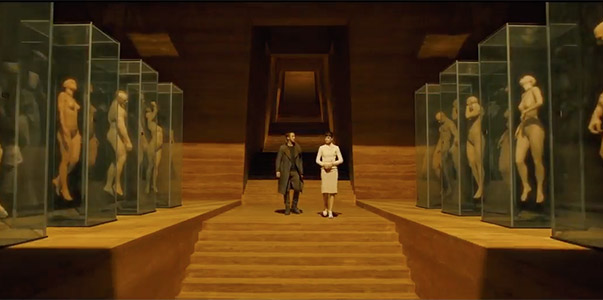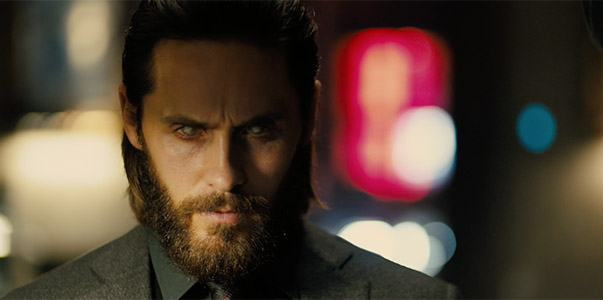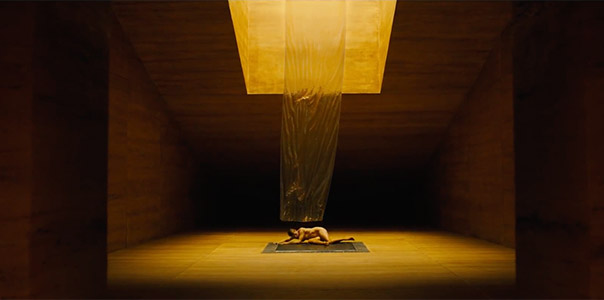Meeting Your Maker: BLADE RUNNER 2049’s Existential Burdens
Brian Walter is a college professor by day and a…
It’s not an easy thing to meet your maker.
Near the end of Blade Runner (1982), Nexus 6 android Roy Batty finally gets to confront Dr. Eldon Tyrell, the reclusive, pyramid-ensconced industrialist who fashioned Roy and his kind to (among other things) live no more than four years. Played with outrageous, scene-chewing glee by Dutch actor Rutger Hauer in a bleached, Billy Idolatrous close-crop, the artificial human reaches into his considerable store of religious reference for a sardonic quip guaranteed to stir the cold c*ckles of any amateur existentialist’s heart.
Indignant Creator
What does it mean to ‘meet your maker’? For Roy, the question is another way of asking what it means to exist at all, especially under the fateful thumb of another’s will, an existentialist black-hole of a question that lies at the heart not just of Ridley Scott’s beloved early 80s sci-fi dystopia, but also of the 1968 novel that inspired it, Philip K. Dick’s Do Androids Dream of Electric Sheep. Some have traced the phrase back to the fourth chapter of Amos, one of the run of obscure prophets near the end of the Old Testament with a flair for reminding Israel that it hasn’t returned to God voluntarily and obediently in its behavior, so it’s going to have to return forcibly, by means of horrible suffering and widespread death, to the indignant bosom of its imprudently ignored creator.
In this understanding, ‘meeting your maker’ is shorthand for the apocalypse, and its evocation by the artificial human a clever way of posing a fundamental existential conundrum: why should homo sapiens exist at all?

It’s never particularly wise to predict anything about a feature film based only on its trailers and other advance publicity, but it certainly looks as if Blade Runner 2049 will readily assume the burden of existentialist intrigue and despair bequeathed to it so memorably by the dark, moody, rain-sodden original. And the part of the doom-saying prophet will apparently be taken by the updated maker himself, Niander Wallace, the manufacturer of a new line of Nexus 6 replicants allegedly guaranteed never to disobey their maker (a lesson Wallace perhaps learned from Tyrell, who, in the original, is left in no shape to continue his work after his reunion with his Judas-kissing ‘prodigal son’).
Blade Runner 2049‘s Blind Prophet
Wallace is played by Jared Leto, who has worn his brown hair long and lank apparently to invite comparisons to Jesus even when he’s not playing an oracle-dropping creator fils to Joe Turkel‘s bespectacled, remote, paternalistically-assured Tyrell in the original. Thickening the symbolic brew, the filmmakers have made Wallace blind, giving Leto the opportunity to fix the camera and the viewer with headily sightless stares that transfix the viewer for Wallace’s oddly-cadenced, self-serving proclamations. When Wallace rationalizes that humanity has always built its civilizations on the broken backs of forced laborers, his sightless power-gaze dares anyone to disagree, a blissfully menacing, twenty-first century Tiresias shunting Oedipus aside to take the throne himself.

As part of the new feature’s advance publicity, Warner Brothers has put out a short film called “Blade Runner 2049 — 2036: Nexus Dawn” (watch) that gives Leto a chance to really strut Wallace’s power-prophet stuff. Arriving at the last minute before an angry, clearly hostile review board for the LAPD, Wallace takes a seat with the assistance of an “angel” whom he has, he tells the magistrates, created.
When the magistrates remind him that the Nexus 6 was outlawed after Tyrell’s debacle in the earlier film, Wallace proceeds to explain that humanity’s only hope for survival is what he has created, which will — he declares with finality — never disobey its human master. Wallace proceeds to demonstrate his angel’s absolute obedience in a simple but visually stark, successfully grandiloquent scene that may leave the viewer as shaken as the magistrates, horrified and mesmerized by a show of power that galvanizes the potency of human creativity at the same time that it decisively alienates us from it.
Artful Dystopias
This is heartening stuff for those of us who don’t quite trust our own nostalgia. Probably most of us old enough to look back fondly on the original Blade Runner as one of the first R-rated movies we managed to sneak into will be looking forward to seeing an aged (but remarkably fit-looking) Harrison Ford back to give doomed detective Rick Deckard one last screen run. The younger generation may appreciate seeing the good-humored Ryan Gosling weather the kind of physical abuse that seems so often required to make male screen stars safe for broheem viewing, their good looks covered over with bruises, cuts, and abrasions perhaps to ensure that cishet male viewers couldn’t find them actually attractive.

Others might appreciate the striking visuals and atmospherics very much on display in the trailers and short story films: the low-key lighting in shallow focus night shots hosting indistinct, edge-faded splotches of glowing colors, the Kubrickian symmetries in Deckard’s hide-out high rise as Gosling’s Officer K arrives in search of his predecessor. Or the clean, dark geometries (highly reminiscent of Tyrell’s pyramid penthouse) that characterize Wallace’s workshop, dropping new androids naked and glistening in some kind of chemical afterbirth into the middle of a bizarrely barren, shadow-lined chamber of richly-stained wood, a curiously masculinized version of a delivery room where Wallace can caress his shuddering, collapsed newborn’s face and wish her a happy birthday.
But for at least a few of us, the real attraction is the promise of a strikingly art-directed twenty-first century update on the dystopias that we continue to imagine into being. It looks like Blade Runner 2049 will give us, in Leto’s Wallace, another chance to meet one of our most dubiously Promethean of makers, the horrifically inspired child of our measureless ambitions spreading ruin in the name of progress and death in the name of order, showing us once again (like an Old Testament prophet raving righteously in the wilderness) that we are, and always have been, our own apocalypse.
What are your expectations of and predictions for Blade Runner 2049?
Blade Runner 2049 will be released in U. S. theaters on October 6th.
Does content like this matter to you?
Become a Member and support film journalism. Unlock access to all of Film Inquiry`s great articles. Join a community of like-minded readers who are passionate about cinema - get access to our private members Network, give back to independent filmmakers, and more.
Brian Walter is a college professor by day and a hopelessly sleepy college professor by night. His work has appeared in a variety of literary and film studies publications, and he appears as an 'old coot' interviewer with a magic camera in the final chapter of Donald Harington's final novel, "Enduring." He lives a short walk from the St. Louis Zoo with his remarkably patient, loving wife and a quirky assortment of canine and feline familiars.













